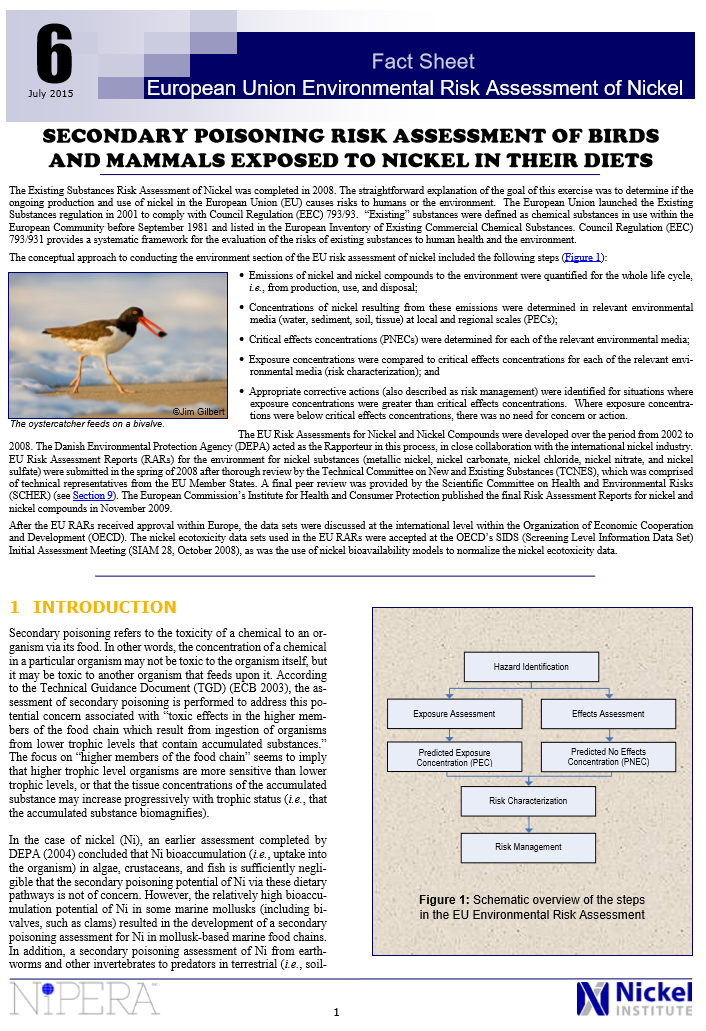The risk characterization combines the results of the PEC, PNEC, and relative bioavailability (i.e., RAF) evaluations. As discussed, the risk characterization was conducted in tiers, with the first tier being the most simplified and subsequent tiers being based on increasing levels of complexity. For each tier, a PEC-to-PNEC ratio, or RCR, was calculated as follows:
RCR = PEC × RAF/PNEC
The RAF was 1 (i.e., 100%) for birds in all tiers and in Tiers 1 and 2 for mammals.
7.1 MARINE
Birds
In Tier 1, the oystercatcher PECs based on a 100% C. edule diet were compared to the generic PNECs of 5.0 and 6.7 mg kg-1. The RCRs suggest a secondary poisoning risk based on the PNEC of 5.0 mg kg-1 but not based on the PNEC of 6.7 mg kg-1. In subsequent tiers, the RCR is reduced to 0.4 when the PNEC is adjusted for the ingestion rate of oystercatcher species and when the PEC is reduced to 0.2 assuming a mixed bivalve diet, as the oystercatcher will not feed exclusively on C. edule. Under this latter more realistic tier, no secondary Ni poisoning risk is estimated (Table 4).
Mammals
In Tier 1, the harbor seal PECs based on either a 100% bivalve diet or a 100% fish diet were compared to the generic PNEC of 0.73 mg kg-1 assuming an RAF of 1. The RCRs are 0.3 and 0.4 for bivalve and fish diets, suggesting no secondary poisoning risk. In subsequent tiers, the RCRs are further reduced when the PNEC is adjusted for the harbor seal food ingestion rate and body weight, and again reduced further to well below 1 if the RAF of 2.5% is incorporated (Table 5).
7.2 FRESHWATER
Birds
In Tier 1, the PECs for a mollusk-eating bird that are representative of the different freshwater eco-regions were compared to the generic PNECs of 5.0 and 6.7 mg kg-1. Regardless of the PNEC used, the RCRs are all less than 0.5 (Table 6), suggesting no secondary poisoning risk in the regional freshwater exposure scenarios. In Tier 2, the PNEC of 12.3 mg kg-1, adjusted for the food ingestion rate and body weight of mollusk-eating birds was used, which resulted in RCRs well below 0.2. This result supports the conclusion of no secondary poisoning risk in the freshwater eco-regions for the bird freshwater food chain.
Mammals
In Tier 1, the European otter PECs that are representative of the different freshwater eco-regions were compared to the generic PNEC of 0.73 mg kg-1 assuming an RAF of 1. The RCRs range from 1.4 to 2.9 in three of the freshwater eco-regions and are <1 in the remaining three eco-region scenarios (Table 7). In Tier 2, which uses a PNEC adjusted for the food ingestion rate of the European otter, all RCRs are <1, and all RCRs are less than ≤0.02 when the RAF of 2.5% is also incorporated (Table 7).
7.3 SOIL
Birds
In Tier 1, regional PECs for a predominantly worm-eating bird were compared to the generic PNECs of 5.0 and 6.7 mg kg-1. All regional RCRs were <1, except for an RCR of 2.4 in the clay soil (see Fact Sheet 5 for additional information on the representative eco-region soils) based on the PNEC of 5.0 mg kg-1 (Table 8). In Tier 2, using the PNEC adjusted for the food ingestion rate of the worm-eating bird slightly lowers the regional RCRs to ≤1.4 assuming a 100% earthworm diet, and to ≤0.8 assuming a 50% earthworm/50% isopod diet.
Mammals
In Tier 1, regional PECs for the shrew were compared to the generic PNEC of 0.73 mg kg-1 assuming an RAF of 1. Several soil eco-region RCRs were >1 (Table 9). In Tier 2, the PNEC of 0.12 mg kg-1, adjusted for the food ingestion rate of the shrew was used, which resulted in higher RCRs because the shrew-adjusted PNEC was lower than the generic PNEC (Table 9). Tier 3 included incorporation of the RAF to account for difference in Ni bioavailability between the PECs and PNECs. For Tier 3, in which a 100% earthworm diet was assumed, two of the soil eco-regions resulted in RCRs >1. The Ni concentrations in these soils were 26 mg kg-1 (peaty soil) and 81 mg kg-1 (clay soil). In Tier 4, it was assumed that the shrew diet contains 30% earthworms and 70% isopods. The RCRs were ≤1.4 when the RAFs of 0.036 and 0.025 for the earthworm and isopod, respectively, were included (Table 9). In just a single regional scenario, the clay soil with a Ni concentration of 81 mg kg-1 resulted in a RCR >1.

